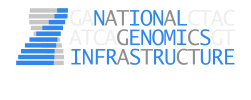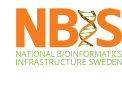Implementing Sarek Pipeline on the University of Florida High Performance Computing Environment
University of Florida High Performance Computing Implementation of Sarek's Pipeline to detect germline or somatic variants from normal or tumour/normal whole-genome, whole exome, or targeted sequencing.
The original Sarek repository has been modified and retrofitted to run on the UF HPC/HiPerGator and instructions are given below.
First, sign up for UFRC account here.
Connect to UFRC Environment (HiPerGator) Using Your Gatorlink Username and Password.
ssh username@hpg.rc.ufl.edugit clone --recursive https://github.com/jongtaek-kim/Sarek UFRC-Sarek
cd UFRC-Sarek$ module load ufrc
$ srundev --time=01:00:00
$ module load nextflow/0.32.0
$ module load singularity/2.5.2
The configuration files have been modified for HiPerGator and a sample SLURM script is provided here.
Download the complete GRCh37 Reference files as shown here or simply copy them from /ufrc/djlemas/jtkim1/UFRC-Sarek/References/GRCh37 if you are inside HiPerGator. Modify the genomes config files (already modified in this git repo).
Run the Pipeline on Real NGS Data. Whole Exome Sequencing Data from Illumina NextSeq Series is Illustrated, which normally outputs a paired-end reads (Forward R1 and Reverse R2 Reads from each lane).
- Example TSV file (UFsampledata.tsv) for a normal/tumor pair with FASTQ files shown below. The complete descriptions are here.
EATL1 XX 0 Normal1 Lane1 UF-data/UF_Testset/Normal1/NS-17-11-BC05-72_S4_L001_R1_001.fastq.gz UF-data/UF_Testset/Normal1/NS-17-11-BC05-72_S4_L001_R2_001.fastq.gz
EATL1 XX 0 Normal1 Lane2 UF-data/UF_Testset/Normal1/NS-17-11-BC05-72_S4_L002_R1_001.fastq.gz UF-data/UF_Testset/Normal1/NS-17-11-BC05-72_S4_L002_R2_001.fastq.gz
EATL1 XX 0 Normal1 Lane3 UF-data/UF_Testset/Normal1/NS-17-11-BC05-72_S4_L003_R1_001.fastq.gz UF-data/UF_Testset/Normal1/NS-17-11-BC05-72_S4_L003_R2_001.fastq.gz
EATL1 XX 0 Normal1 Lane4 UF-data/UF_Testset/Normal1/NS-17-11-BC05-72_S4_L004_R1_001.fastq.gz UF-data/UF_Testset/Normal1/NS-17-11-BC05-72_S4_L004_R2_001.fastq.gz
EATL1 XX 1 Tumor1 Lane1 UF-data/UF_Testset/Tumor1/W6172-00_S1_L001_R1_001.fastq.gz UF-data/UF_Testset/Tumor1/W6172-00_S1_L001_R2_001.fastq.gz
EATL1 XX 1 Tumor1 Lane2 UF-data/UF_Testset/Tumor1/W6172-00_S1_L002_R1_001.fastq.gz UF-data/UF_Testset/Tumor1/W6172-00_S1_L002_R2_001.fastq.gz
EATL1 XX 1 Tumor1 Lane3 UF-data/UF_Testset/Tumor1/W6172-00_S1_L003_R1_001.fastq.gz UF-data/UF_Testset/Tumor1/W6172-00_S1_L003_R2_001.fastq.gz
EATL1 XX 1 Tumor1 Lane4 UF-data/UF_Testset/Tumor1/W6172-00_S1_L004_R1_001.fastq.gz UF-data/UF_Testset/Tumor1/W6172-00_S1_L004_R2_001.fastq.gz- Run the Nextflow Script as shown below.
nextflow run main.nf --sample UF-data/UFsampledata.tsv --step mapping --genome GRCh37 --genome_base References/GRCh37 --tag latest -profile singularity
TMB represents the amount of neoantigen that immune system has not previously been exposed to, in context of cancer and Immunotherapy.
*Supplement Above TMB Calculation with Microsatellite Instability Analysis here and Mutational Signature Analysis here.
An open-source analysis pipeline to detect germline or somatic variants from whole genome or targeted sequencing
Previously known as the Cancer Analysis Workflow (CAW), Sarek is a workflow designed to run analyses on WGS data from regular samples or tumour / normal pairs, including relapse samples if required.
It's built using Nextflow, a domain specific language for workflow building. Software dependencies are handled using Docker or Singularity - container technologies that provide excellent reproducibility and ease of use. Singularity has been designed specifically for high-performance computing environments. This means that although Sarek has been primarily designed for use with the Swedish UPPMAX HPC systems, it should be able to run on any system that supports these two tools.
Sarek was developed at the National Genomics Infastructure and National Bioinformatics Infastructure Sweden which are both platforms at SciLifeLab. It is listed on the Elixir - Tools and Data Services Registry.
Sarek is built with several workflow scripts. A wrapper script contained within the repository makes it easy to run the different workflow scripts as a single job. To test your installation, follow the tests documentation.
Raw FastQ files or aligned BAM files (with or without realignment & recalibration) can be used as inputs. You can choose which variant callers to use, plus the pipeline is capable of accommodating additional variant calling software or CNV callers if required.
The worflow steps and tools used are as follows:
- Preprocessing -
main.nf(based on GATK best practices)- Map reads to Reference
- Mark Duplicates
- Base (Quality Score) Recalibration
- Germline variant calling -
germlineVC.nf- SNVs and small indels
- Structural variants
- Somatic variant calling -
somaticVC.nf(optional) - Annotation -
annotate.nf(optional)- Variant annotation
- Reporting -
runMultiQC.nf- Reporting
The Sarek pipeline comes with documentation in the docs/ directory:
- Installation documentation
- Installation documentation specific for UPPMAX
rackham - Installation documentation specific for UPPMAX
bianca - Tests documentation
- Reference files documentation
- Configuration and profiles documentation
- Intervals documentation
- Running the pipeline
- Command line parameters
- Examples
- Input files documentation
- Processes documentation
- Documentation about containers
- More information about ASCAT
- Output documentation structure
If you would like to contribute to this pipeline, please see the contributing guidelines.
For further information or help, don't hesitate to get in touch on Gitter or contact us: maxime.garcia@scilifelab.se, szilveszter.juhos@scilifelab.se
Main authors:
Helpful contributors:
- Johannes Alneberg
- Sebastian DiLorenzo
- Jesper Eisfeldt
- Phil Ewels
- Max Käller
- Malin Larsson
- Marcel Martin
- Björn Nystedt
- Pall Olason
- Aron Skaftason















